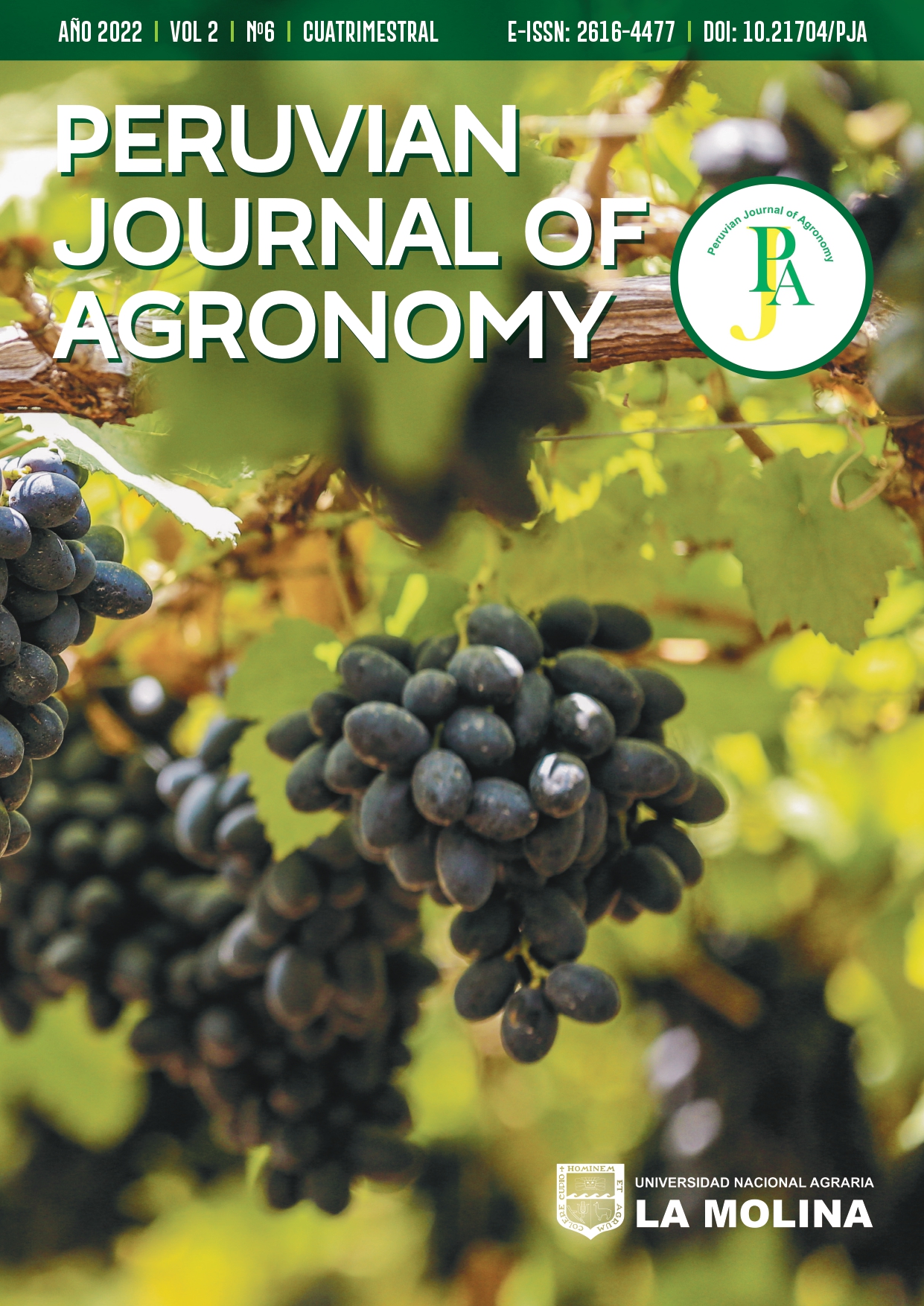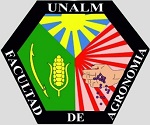Efectos de Salinidad de tres Cultivares de Mandarina en dos Patrones diferentes
DOI:
https://doi.org/10.21704/pja.v6i2.1930Palabras clave:
Mandarina, estrés salino, patrón, ‘Cleopatra’, “Citrumelo Swigle”Resumen
Cítricos, es uno de los más importantes cultivos de frutales en el mundo y son susceptibles a sales. Los efectos negativos de las sales generalmente reducen producción y calidad de fruta. Para evaluar los efectos de la salinidad en algunos parámetros de crecimiento, un experimento en invernadero fue conducido con los cultivares ‘Mihowase’, ‘Primosole’ y ‘W. Murcott’ en los patrones ‘Cleopatra’ y ‘Swingle citrumelo’ El experimento fue conducido en la Estación Experimental Agraria (EEA) del Instituto Nacional de Innovación Agraria (INIA), Huaral-Donoso a 90 km al norte de Lima. Las plantas fueron irrigadas con una solución salina ClNa y con una conductividad eléctrica de 0.5 o 4.5 dS/m. Las variables evaluadas fueron caídas de hojas, peso fresco y seco de tallos, hojas y raíces y contenido de agua por las plantas. Los resultados mostraron que el patrón ‘Cleopatra’ es más tolerante que ‘Swingle citrumelo’. Las variedades afectaron todas las variables de los dos patrones, siendo más notorio en la cantidad de pelos absorbentes de las raíces. La selección de plantas de mandarinas para producción debería considerar combinación variedad/patrón.
Descargas
Referencias
Acosta, J. R., Ortuno, M. F., Bernal, A., Diaz, P., Sanchez, M. J., & Hernandez, J. A. (2017). Plant responses to salat stress: Adaptive mechanims. Agron. Journal, 7(18), 1–38. https://doi.org/10.3390/agronomy7010018
Brito, M., Sonale, K., Dantas, P., Raj, H., Fernandes, J., Dos Santos, W., Soares, A., & Azevedo, D. (2014). Growth of undergrafted and grated citrus rootstocks under saline water irrigation. African Journal of Agricultural Research, 9(50), 3600–3609. https://doi.org/10.5897/2014.9039
Etehadpour, M., Fatahi, R., Zamani, Z., Golein, B., Naghavi, M. R., & Gmitter, F. (2020). Evaluation of the salinity tolerance of Iranian citrus rootstocks using morph-physiological and molecular methods. Sci. Hortic., 261, 109012. https://doi.org/10.1016/j.scienta.2019.109012
Ferguson, L., & S. R. Grattan. (2005). How salinity damages citrus: Osmotic effects and specific ion toxicities. HortTechnology, 15(1), 95–99. https://doi.org/10.21273/HORTTECH.15.1.0095
Farhangi, S., & Torabian, S. (2017). Antioxidant enzyme and osmotic adjustment changes in bean seedlings as affected by biochar under salt stress. Ecotoxicol. Environ., 137, 64–70. https://10.1016/j.ecoenv.2016.11.029
Garcia, M. R., Bernet, G. P., Puchades, J., Gomes, I., Cabonell, E. A., & Asins, M. J. (2016). Reliable and easy screening technique for salt tolerance of citrus rootstock under controlled environment. Austral. J. Agr. Res., (53), 653–662. https://doi.org/10.1071/AR01071
Gonzales, D. (2017). Patrones y variedades de cítricos. Un recorrido histórico [Master thesis, Universidad Miguel Hernández de Elche].
Hasanuzzaman, M., Hossain, M., Chowdhury, A., Rahman, K., Nowroz, F., Rahman, M., Nahar, K., & Fujita, M. (2021). Regulation of reactive oxygen species and antioxidant defense in plants under salinity. Int. J. Mol. Sci., 22(17), 9326. https://doi.org/10.3390/ijms22179326
Khoshbakht, D., Asghari, M., & Haghighi, M. (2018). Effects of foliar applications of nitric oxide and spermidine on chlorophyll fluorescence, photosynthesis and antioxidant enzyme activities of citrus seedlings under salinity stress. Photosynthetica, 56, 1313–1325. https://doi.org/10.1007/s11099-018-0839-z
Lauchli, A., & Epstein, F. (1990). Plant responses to saline and sodic conditions. In K. K. Tanj (Ed.), Agricultural salinity assessment and management (pp.113–137). ASCE Manual and Rpts. on Eng. Practice Nº 71 Amer. Soc. Chem. Eng.
Mahmoud, L., Dutt, M., Vicent, Ch. I., & Grosser, J. D. (2020). Salinity-induced Physiological Responses of Three Putative Salt Tolerant Citrus Rootstocks. Horticulturae 6(4) 90–94. https://doi:10.3390/horticulturae6040090
Navarro, J., Lopez, A., Garcia, B., Andujar, J., Tallon, C., & Porras, I. (2010). Estudios de la respuesta a la salinidad de diferentes patrones de cítricos. XII Congreso Iberico de Horticultura. Actas, 112-115
Rodrigues, M. J. Da S., Romero, A., Sebastiao, E., Dos Santos, W., Giraldi, E. A., Saraiva L., & Oliveira. U. (2019). Performance of ‘Valencia’ sweet orange grafted onto rootstocks in the state of Acre. Brazil. Pesq. Agropec. Bras., (54), 56–62. https://doi.org/10.1590/S1678-3921.pab2019.v54.01349
Simpson C.R., Nelson, S., Melgar, J., Jifon, J., Schuster G., & Volder. A. (2014). Growth response of grated and ungrafted citrus trees to saline irrigation. Sci. Horticult. 169, 199–205. https://doi/10.1016/J.SCIENTA.2014.02.020
Siddiqui, H., Hayat, S., & Bajguz, A. (2018). Regulation of photosynthesis by brassinosteroids in plants. Acta Physiol Plant, 40(3), 59. https://doi.org/10.1007/s11738-018-2639-2
Syvertsen, J. P, Lloyd J. & Riedmann, E. (1988). Salinity and drought effects on foliar ion concentration, water relation, and photosynthetic characteristics of orchard citrus. Australian Journal of Agricultural Research, 39, 619–627
Vardi. A., Spiegel-Roy R., Ben Hayim, G., Neumann, H., & Shalhevet, J. (1988). Response of Shamouti orange and Minneola tangelo on six rootstocks to salt stress. Proc. 6th Intl. Citrus Congr., 1,188-192
Ziogas, V., Tanau, G., Morianou, G., Kourgialas, N., & Kourgialas, N. (2021). Drought and Salinity in Citriculture. Optimal Practices to alleviate salinity and Water Stress. Agronomy, 11(7), 1 – 15. https://doi.org/10.3390/agronomy11071283
Zahra, N., Ali, Z., & Mahmood, S. (2020). Effect of salinity stress on various growth and physiological attributes of two contrastring maize genotypes. Agriculture, Agribusiness and Biotechnology, 63, 1-10. http://doi.org/10.1590/1678-4324-2020200072
Descargas
Publicado
Número
Sección
Licencia
Derechos de autor 2022 R. Velásquez, C. Burga, L. Vargas

Esta obra está bajo una licencia internacional Creative Commons Atribución 4.0.











